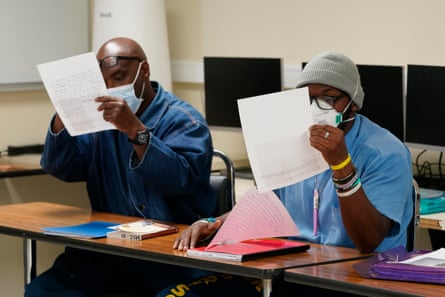The California governor Gavin Newsom has announced a plan to transform the state’s oldest prison into a center for rehabilitation, education and training, modeled after Norwegian incarceration systems, which are much less restrictive than US facilities.
Newsom told the Los Angeles Times on Thursday that his goal is “ending San Quentin [prison] as we know it” and working to “completely reimagine what prison means”. San Quentin, located on a peninsula in the San Francisco Bay Area and established in 1852, houses nearly 4,000 people, including hundreds on its infamous death row, the largest in the US, which is on track to be dismantled.
The Democratic governor said that by 2025, he plans to transition the massive penitentiary into a final stop of incarceration before individuals are released, with a focus on job training for trades, including plumbers, electricians or truck drivers, the LA Times reported. His recently released budget proposal includes $20m to start the effort.
“The ‘California Model’ the governor is implementing at San Quentin will incorporate programs and best practices from countries like Norway, which has one of the lowest recidivism rates in the world – where approximately three in four formerly incarcerated people don’t return to a life of crime,” the governor’s office said in a statement on Thursday. The prison will be renamed the San Quentin Rehabilitation Center.

The transformation Newsom has described would, at least for San Quentin, mark a fundamental shift from the extremely punitive American system. The US has the highest reported incarceration rate in the world, with nearly 2 million people behind bars at any given time; starting in the 1980s, state prison populations began dramatically expanding across the country as “tough on crime” efforts created mandatory long and indefinite sentences and locked up youth for life.
Although California is considered a leader in criminal justice reform, the state’s prison system continues to be overcrowded, with thousands of elderly people languishing behind bars and Black residents disproportionately imprisoned for decades due to harsh sentencing laws adopted in the 1990s.
Scandinavian models of incarceration that have garnered increasing attention from some US lawmakers are less focused on punishment and are meant to give imprisoned people support and a sense of normal life behind bars so that they are prepared to reintegrate into society. That can mean access to personal computers, televisions and showers, consistent classes and programming, fresh food, more freedom of movement and stronger connections with the outside world.
“Do you want them coming back with humanity and some normalcy, or do you want them coming back more bitter and more beaten down?” Newsom told the LA Times.

An overhaul of San Quentin would be a huge undertaking, and there are significant unanswered questions about what the transition would mean for its current residents as well as the tens of thousands of others located across the California department of corrections and rehabilitation (CDCR). San Quentin has a long and recent history of scandals involving abuse, overcrowding, guard misconduct and medical neglect. It is also a prison that has significantly more programming than some of the remote and rural CDCR prisons, with a renowned podcast produced by incarcerated San Quentin journalists.
The governor’s office noted research showing that every $1 spent on rehabilitation saves more than $4 on costs of re-incarceration; that people who enroll in education programs behind bars are 43% less likely to return to prison; and that crime survivor groups say victims prefer sentences that include programming designed to prevent recidivism. Helping people “return to their communities as productive members of society” is critical in a state where roughly 35,000 people are released from prison every year, the office added.
Newsom said this kind of transformation has never been pursued at this scale in the US and that he hopes San Quentin would be a model for the nation.
James King, co-director of programs for the Ella Baker Center for Human Rights, who spent six years imprisoned in San Quentin, said it was good to see a push to prioritize rehabilitation, but that he was skeptical of CDCR’s ability to fundamentally reinvent itself.
“The culture of CDCR and the [correctional officers’ union] is extremely biased against incarcerated people, and it’s going to take a lot more than a policy change to change that,” he said, adding that the San Quentin facilities are more than 100 years old and weren’t designed for classes, programming and environments that promote healing. “I don’t know if there’s a feasible way to have people trained by CDCR, who are rooted in a very discriminatory mode of being toward the people they are incarcerating, facilitate a shift in culture.”
He said he hoped to see the governor continue to close more prisons and push for alternatives to incarceration and sentencing reforms that allow people to come home: “There’s no humane way to hold people in captivity. The answer to creating safer communities is not found in building better prisons. Prisons are fundamentally harmful to our society, and to any notions of justice or safety.”

 2 years ago
589
2 years ago
589 
















 English (United States) ·
English (United States) ·